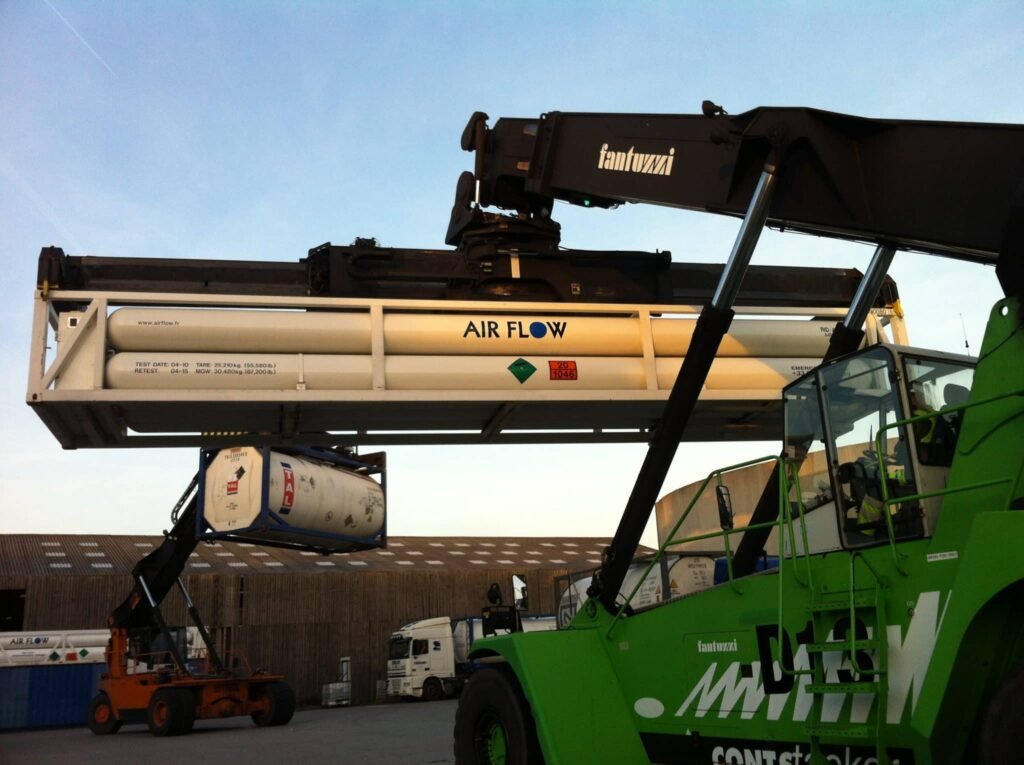The compressed hydrogen supply chain is organized as a rake, while that of liquid energies is organized as a star. This difference partly explains the high cost of transporting hydrogen. The company Airflow explains to us the implications of the complex logistics of the hydrogen molecule.
Compressed hydrogen is stored and transported mainly in compressed form in steel cylinders, at 200 bar pressure. More rarely, it is stored/transported in steel bottles reinforced with carbon fiber, or even in “plastic” bottles lined with carbon fiber. In these rare cases, pressures can reach 700 bars.
Loading/unloading vehicles
Hydrogen transport vehicles have a storage capacity generally between 100 and 300 kg. The loading plants, which operate under the control of expert technicians, are equipped with compressors with a capacity of 50 to 100 kg per hour. To fill your transport vehicle with hydrogen, you will need to place your storage chassis at a loading station and pick it up several days later: 1 to 3 days are necessary to fill a vehicle, including half a day for the phase filling. The other deadlines are those of positioning on the site, security checks before and after filling and waiting time.
Figure 1
In Figure 1, we visualize the high number of filling stations, emphasizing the fact that the transport of hydrogen requires a very large number of storage and transport equipment, which inevitably leads to high storage costs. Conversely, loading a liquid energy transport vehicle is a rapid operation. A driver will typically take 2 hours from the time he arrives at the factory with empty storage to the time he leaves full. Figure 2 demonstrates that, unlike hydrogen, liquid energy requires only 3 loading stations (compared to 18 for hydrogen!), which considerably reduces the cost of storage and the associated maintenance costs.
Figure 2
The transfer of hydrogen from one tank to another requires compressors that are difficult to use: they are energy-intensive, heavy, complex and sensitive to external aggression (rain, vibrations, shocks, etc.). For technical and economic reasons, and in the current state of our technologies, it is impossible to install a transfer compressor on hydrogen transport vehicles, and to consider installing a hydrogen compressor on each point of consumption (safety reason). The solution: “drop” the transport chassis at the point of consumption. Conversely, unloading a liquid energy vehicle is a quick and safe operation, taking less than 2 hours. Transfer pumps are small, reliable and inexpensive. It is easy to install on a vehicle or at a consumption point.
Hydrogen involves a logistical organization different from other energies. In fact, this is organized in a rake: a high number of transport vehicles are required to supply an equally high number of consumption points. Conversely, the capacity to transfer liquid energies makes their logistics chain a hub-and-spoke organization, economical in terms of storage and transport: a large reservoir supplies a reasonable number of transport vehicles which supply a high number of points of sale. consumption.
Most consumption points cannot afford a disruption in supply and must ensure continuity of operation: this is why they are equipped with two storage vehicles. The first supplies hydrogen to the consumption point, while the second, full, is connected and waiting. A simple and reliable system is triggered when the first one empties and starts the waiting vehicle. This rotation system gives time for the storage vehicle to return to the production center with the empty tank to fill it while the other is unloading, and so on. The document opposite clearly shows the two trailers, one unloading and one waiting. Some consumption points that are very sensitive to continuity of supply even require 3 vehicles: one in service, a second connected on standby, and a third as backup in the event of overconsumption, transport problems, supply problems, etc.
Very high pressure: the solution?
The new “carbon fiber” storages make it possible to store and transport approximately twice as much hydrogen per rotation. Variable transport costs decrease accordingly. But you will still need three vehicles: one for filling, one for transport and one at the point of consumption. The new “carbon fiber” vehicles do not reduce fixed costs, they even increase them significantly, this equipment being two to four times more expensive than steel vehicles. So this seems like a sham solution. This is why, in Europe, more than 95% of compressed hydrogen transport is still done in steel vehicles. Given the high number of storages specific to the hydrogen supply chain, it is better to operate vehicles with low capacity and low cost.

